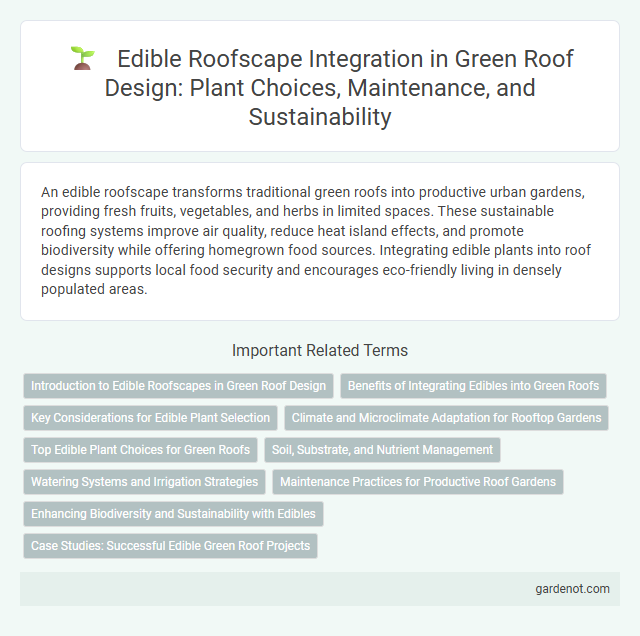An edible roofscape transforms traditional green roofs into productive urban gardens, providing fresh fruits, vegetables, and herbs in limited spaces. These sustainable roofing systems improve air quality, reduce heat island effects, and promote biodiversity while offering homegrown food sources. Integrating edible plants into roof designs supports local food security and encourages eco-friendly living in densely populated areas.
Introduction to Edible Roofscapes in Green Roof Design
Edible roofscapes integrate food-producing plants into green roof systems, enhancing urban agriculture and biodiversity. These sustainable designs support growing vegetables, herbs, and fruits on rooftops, promoting local food production and reducing food miles. Incorporating edible plants in green roof design also improves insulation, stormwater management, and air quality while creating productive green spaces in urban environments.
Benefits of Integrating Edibles into Green Roofs
Integrating edibles into green roofs enhances urban food security by providing fresh, locally grown produce that reduces carbon emissions associated with transportation. Edible roofscapes improve biodiversity and create habitats for pollinators, supporting ecosystem health in densely populated areas. Their ability to regulate building temperatures contributes to energy savings, while offering aesthetically pleasing, sustainable food production spaces.
Key Considerations for Edible Plant Selection
Selecting edible plants for a green roof requires prioritizing species that tolerate shallow soil, fluctuating temperatures, and limited water availability. Opt for drought-resistant herbs like thyme and rosemary, alongside hardy vegetables such as kale and lettuce, which thrive under rooftop conditions. Consider sun exposure, wind protection, and nutrient requirements to ensure sustainable growth and maximize yield on the edible roofscape.
Climate and Microclimate Adaptation for Rooftop Gardens
Edible roofscapes offer significant climate adaptation benefits by reducing urban heat island effects and improving rooftop microclimates through natural insulation and evapotranspiration. These rooftop gardens enhance local air quality and moisture retention, creating cooler ambient temperatures and mitigating temperature extremes in dense urban areas. Integrating edible plants on rooftops promotes sustainable urban agriculture while providing microclimate regulation critical for climate resilience.
Top Edible Plant Choices for Green Roofs
Top edible plant choices for green roofs include hardy, drought-tolerant varieties such as herbs like thyme, oregano, and chives, which thrive in shallow soil and require minimal maintenance. Succulent varieties like sedum provide both greenery and resilience, while leafy greens such as lettuce and spinach can flourish in well-drained rooftop environments. Incorporating these plants into green roof designs enhances urban food production, supports biodiversity, and improves rooftop thermal performance.
Soil, Substrate, and Nutrient Management
Edible roofscape systems rely heavily on nutrient-rich, lightweight soil substrates that balance water retention, drainage, and aeration to support diverse plant growth. Optimized substrate blends often include organic matter, compost, and engineered materials to enhance fertility while minimizing weight load on the roof structure. Effective nutrient management involves regular monitoring and supplementation to maintain optimal levels of nitrogen, phosphorus, and potassium, ensuring robust yields and healthy crop development in rooftop environments.
Watering Systems and Irrigation Strategies
Edible roofscapes require efficient watering systems such as drip irrigation and automated timers to maintain optimal moisture levels for diverse plant species, enhancing water conservation and crop yield. Integrating rainwater harvesting and smart sensors allows precise irrigation scheduling, reducing water waste and supporting sustainable urban agriculture. Advanced moisture monitoring technologies promote healthier edible plants by ensuring consistent hydration tailored to specific rooftop microclimates.
Maintenance Practices for Productive Roof Gardens
Effective maintenance practices for edible roofscapes include regular irrigation management, pest control using organic methods, and periodic soil enrichment through compost application. Monitoring plant health and pruning promotes vigorous growth, while installing automated drip irrigation systems ensures consistent moisture levels. Seasonal crop rotation and the removal of weeds reduce disease risk and optimize productivity in rooftop gardens.
Enhancing Biodiversity and Sustainability with Edibles
Edible roofscapes transform urban green roofs into productive ecosystems, supporting pollinators like bees and butterflies while improving air quality and reducing urban heat islands. Incorporating diverse edible plants such as herbs, vegetables, and fruits promotes local food production and reduces carbon footprint associated with transportation. These sustainable roof gardens enhance biodiversity by creating habitats for various insects and birds, fostering ecological balance in urban environments.
Case Studies: Successful Edible Green Roof Projects
Successful edible green roof projects, such as the Brooklyn Grange in New York City, demonstrate the potential for urban agriculture to enhance food security and biodiversity. The City Farm in Melbourne exemplifies sustainable design by integrating native plants and edible crops, resulting in improved local microclimates and community engagement. Research on the Berggarten Botanical Garden's edible roof in Hannover highlights increased crop yield and reduced urban heat island effects, validating the environmental and social benefits of edible roofscapes.
Edible roofscape Infographic

 gardenot.com
gardenot.com